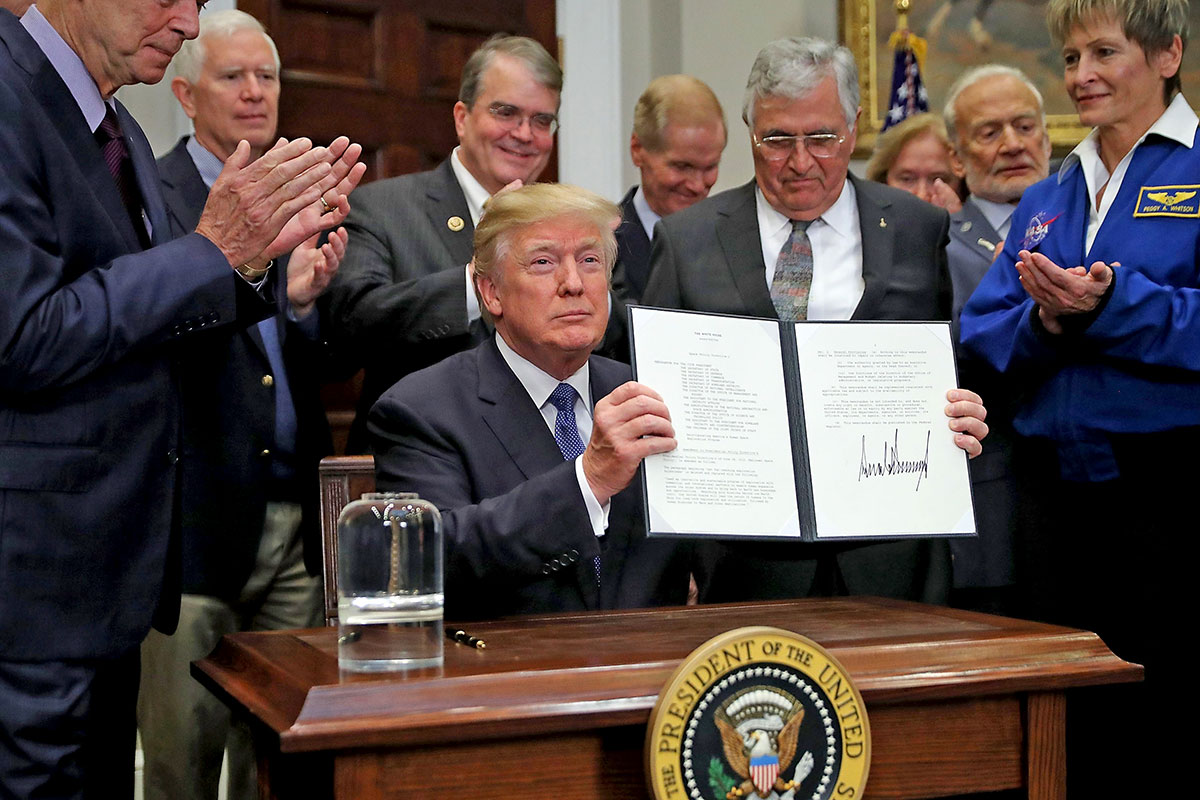President Trump Directs NASA to Return to the Moon, Then Aim for Mars
President Donald Trump signed his administration's first space policy directive today (Dec. 11), which formally directs NASA to focus on returning humans to the moon.
President Trump signed the order during a ceremony in the Oval Office, surrounded by members of the recently re-established National Space Council, or NSC (which provides recommendations to the president on space policy), as well as active NASA astronauts Christina Hammock Koch and Peggy Whitson, Apollo 11 astronaut Buzz Aldrin, and retired astronaut Jack Schmitt, who flew to the moon on the Apollo 17 mission.
"Exactly 45 years ago, almost to the minute, Jack [Schmitt] become one of the last Americans to land on the moon," Trump said. "Today, we pledge that he will not be the last." [From Ike to Trump: Presidential Visions for Space Exploration]

"The directive I'm signing today will refocus America's space program on human exploration and discovery," Trump said during the ceremony. "It marks an important step in returning American astronauts to the moon for the first time since 1972, for long-term exploration and use. This time we will not only plant our flag and leave our footprint — we will establish a foundation for an eventual mission to Mars and perhaps someday to many worlds beyond."
Space Policy Directive 1 makes official a recommendation approved by the NSC in October. Vice President Mike Pence, who serves as chairman of the NSC, also spoke at the signing. [In Photos: President Trump's Administration and NASA]
"Mr. President, you've said that the pioneer spirit has always defined America," Pence said. "And by your action today — with this clear vision [of] returning Americans to the moon, preparing to lead to Mars and beyond — you are ensuring, Mr. President, that America will lead in space in the future and for generations to come."
In Photos: President Trump Aims for the Moon with Space Policy Directive 1
Get the Space.com Newsletter
Breaking space news, the latest updates on rocket launches, skywatching events and more!
NASA recently announced that for human astronauts, the path to Mars will include a stop at the moon, where the agency may build a facility currently being called the Deep Space Gateway. That structure could serve as a kind of way station between the Earth and the Red Planet. (The concept for this particular lunar way station has been around for at least five years.)
Robert Lightfoot, NASA's acting administrator, said he thinks the new directive could provide "a sense of urgency" to NASA's spaceflight pursuits. He noted that there are "a lot of people that want to help [NASA]" reach those goals, including international space partners and commercial space partners in the U.S.
"And if we can all stay focused on the same goal, we'll be okay," Lightfoot said.
In a separate statement, NASA officials said that the directive also officially ends NASA's Asteroid Redirect Mission (ARM), which would have sent robotic probes and then humans to an asteroid. The Space Policy Directive 1 will "more effectively organize government, private industry, and international efforts toward returning humans [to] the Moon, and will lay the foundation that will eventually enable human exploration of Mars," agency officials said.
Both the president and the vice president said today that NASA's focus on its human spaceflight program will help create jobs for the country, and both men briefly mentioned the defense and military applications of the space program.
"As everyone here knows, establishing a renewed American presence on the moon is vital to achieve our strategic objectives and the objectives outlined by our National Space Council," Pence said. "In pursuing these objectives, Mr. President, we will, as you said, enhance our national security and our capacity to provide for the common defense of the people of the United States of America."
The Commercial Spaceflight Federation — a member organization for human spaceflight companies — released this statement from its president, Eric Stallmer: "CSF applauds President Trump for signing Space Policy Directive 1, which directs NASA to partner with the U.S. commercial space industry to return Americans to the Moon. The U.S. commercial space industry has invested hundreds of millions of dollars in private capital to develop innovative capabilities for lunar transport, operations, and resource utilization. CSF recommends that the Administration direct NASA to leverage these capabilities to generate greater efficiency, as well as partner with industry through flexible, innovative contracting approaches, to accelerate progress towards achieving the goals set out in Space Policy Directive."
Follow Calla Cofield @callacofield.Follow us @Spacedotcom, Facebook and Google+. Original article on Space.com.
Join our Space Forums to keep talking space on the latest missions, night sky and more! And if you have a news tip, correction or comment, let us know at: community@space.com.

Calla Cofield joined Space.com's crew in October 2014. She enjoys writing about black holes, exploding stars, ripples in space-time, science in comic books, and all the mysteries of the cosmos. Prior to joining Space.com Calla worked as a freelance writer, with her work appearing in APS News, Symmetry magazine, Scientific American, Nature News, Physics World, and others. From 2010 to 2014 she was a producer for The Physics Central Podcast. Previously, Calla worked at the American Museum of Natural History in New York City (hands down the best office building ever) and SLAC National Accelerator Laboratory in California. Calla studied physics at the University of Massachusetts, Amherst and is originally from Sandy, Utah. In 2018, Calla left Space.com to join NASA's Jet Propulsion Laboratory media team where she oversees astronomy, physics, exoplanets and the Cold Atom Lab mission. She has been underground at three of the largest particle accelerators in the world and would really like to know what the heck dark matter is. Contact Calla via: E-Mail – Twitter









